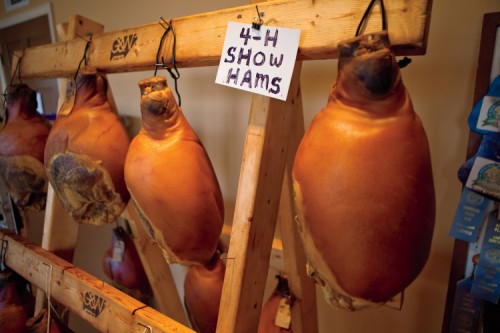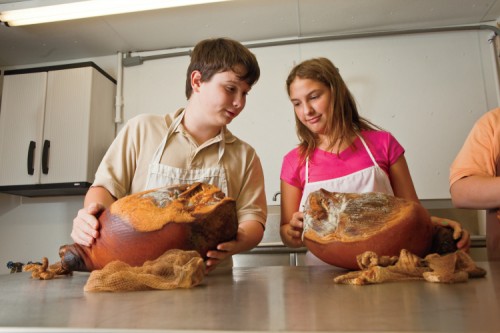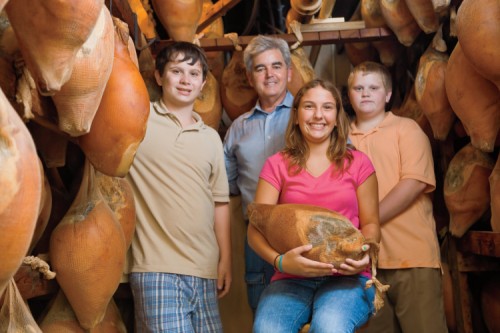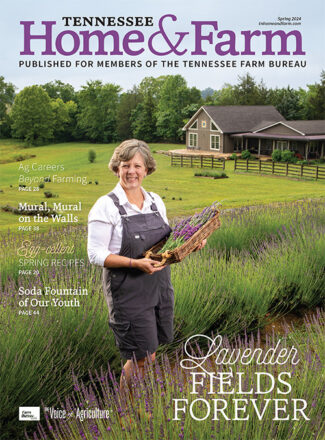The Hamery: 4-H Members Learn to Cure Country Hams
Not much has changed in the two centuries since Bob Woods’ ancestors loaded up the wagon and headed for Tennessee.
“I was thinking about that the other day,” Woods was saying recently. “When they came over from North Carolina, they had a few hogs trailing behind them and probably had some country hams hanging in that wagon to help them survive their trip. And when they got to Rutherford County, they probably killed those hogs and salted the hams to survive.”
Today, Woods carries on the family tradition from The Hamery in Murfreesboro, where he cures and sells about 1,500 hams a year using the same main ingredients his ancestors used more than 200 years ago – salt and time.
No matter how you slice it, Bob Woods says, you can’t have a good country ham without both. That’s a philosophy his family has handed down for generations, and is now being passed on to Rutherford County 4-H’ers as part of the Heritage Skills Country Ham Project.

“Each generation has a responsibility to the next generation to pass on their knowledge and sense of tradition,” says Woods. “Along the way, when we cure these hams, we’re telling these kids about how our forefathers survived in this country without electricity, without refrigeration, by curing hams and pork. So it’s a very educational process that goes with curing the ham. We try to pass that on.”
“The project helps the kids understand the science of preserving meat, using salt and sugar techniques,” said Bob Ary, a University of Tennessee Extension agent who chairs the country ham show at the Tennessee State Fair. “It’s one of those skills we don’t use much anymore, but it might spur an interest in food science.”
The Hamery’s curing process itself was handed down from Woods’ grandfather to his uncle, Sam “Little Doc” Woods, and a partner, Col. Tom Givan. Before opening The Hamery in 1969, the two had complained, “Those store-bought hams are being cured so fast they don’t even have time for the squeal to leave.”
After inheriting The Hamery in 1981, Bob Woods also recognized the value of time in the curing process. Today, he follows the same basic “recipe” to teach the 4-H kids as they go through the yearlong process.

The teaching begins in early January when 1,500 “green,” or uncured, hams arrive by tractor-trailer truck from a hog farmer in the Midwest. From that shipment, the students choose two hams each – one as part of their project and one to be auctioned off in a 4-H fundraiser.
Within the first 10 days of their arrival, the hams will be lightly rubbed with a dry mixture of salt and sugar (saltpeter is no longer used due to health concerns) on three separate occasions and placed back into refrigeration after each rubbing.
The hams are kept refrigerated until mid-February when the outside temperature falls to 55 degrees. They are then removed from storage, lightly pressure-washed and hung in stockinettes to dry. After two weeks of drying, the hams are ready to smoke. Sticks and limbs from his friend’s apple orchard and hickory wood are heaped in metal troughs and set afire with circulating fans sending the smoky air wafting around the room over four or five days. The hams then hang there throughout the dog days of summer, shrinking by as much as 30 to 40 percent but growing tastier each passing day.
“Then, right before September, the 4-H kids come back and get the ham out of the aging room,” Woods says. “It’s quite an experience to see those youngsters’ eyes bulge when they see that pretty ham they put up is now covered with mold. They can’t believe that’s their ham, but it doesn’t hurt anything. They just take it out, wash it and get it ready for the Tennessee State Fair and Spring Hill Country Ham Festival.”

Not surprisingly, the 4-H students fare well in the contests in which the hams are judged on appearance, smell and fat content. In fact, Savannah Sandlin’s ham from The Hamery won the grand champion award at the 2011 state fair, besting adult entrants. Still, Scott Ayers, a Christiana seventh-grader who took Best of Show at last year’s Spring Hill Country Ham Festival, modestly says his victory was nothing but “luck.”
However, his older brother Holden says there’s more to it than that. “Showing cattle in 4-H is a lot of work (but) the ham project is a whole lot of waiting,” he says. “It takes patience for both of them. It’s amazing how long it takes to cure a ham.”
Ham for the Holidays
The Hamery is open year-round Wednesday-Saturday, 9 a.m. to 3 p.m., at 411 W. Lytle St., Murfreesboro, TN 37130. For more information, call (615) 893-9712 or visit www.thehamery.com. The Hamery’s products also include its version of Tennessee prosciutto.
Hungry for More?
Check out Bob Woods’ recipe for Coca-Cola country ham, or learn about his new product, the Tennessee version of prosciutto.















Love their ham!
I grew up on a farm and we killed our own hogs every year. My daddy would salt the hams and shoulders and the “middling” (bacon) down with salt. Then he would clean it off and rub it down with black pepper and borax and hang it to dry. There is nothing better than country ham (in my opinion) with homemade biscuits and gravy!
I am orginally from a small town in Geogia. The small town attmosphere and the old fashion principles are a way of life. Kids are taught their education throgh hands on projects. I cant wait to share ur ham projects for science class. Thank u for posting this online!!